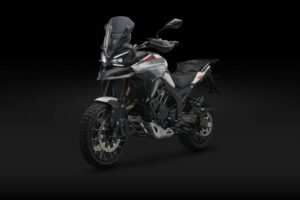Is the Kawasaki Ninja still the most iconic bike of all time?
Image credit Kawasaki images
Since 1984 the Kawasaki Ninja has been synonymous with power, precision and excitement. We take a look at this beloved bike and examine why it has remained popular for 40 years.
Ninjas were having a bit of a moment in the pop culture of 1984. A string of variable quality films featuring them were in the cinema, with ninja-themed video games regular sights in arcades. The Teenage Mutant Ninja Turtles also made their debut this year, and would develop from an unlikely indie comic hit into a multimedia franchise that continues to this day.
There was even a Ninja cologne, which seems like a fitting 80s update on the quintessential 70s men’s fragrance Hai Karate – which produced an iconic commercial. With ninjas permeating the popular imagination to this level, it seems like an inevitability that one of the Japanese motorcycle manufacturers would have picked it as a name for one of their bikes -and it was Kawasaki that took the initiative.
The birth of the Kawasaki Ninja
![]() Image credit Kawasaki images
Image credit Kawasaki images
The GPZ900R Ninja is the first motorcycle Kawasaki released with the name and it’s difficult to overstate the impact it had. Using the world’s first 16-valve liquid-cooled inline four-cylinder motorcycle engine, it helped to redefine what a sports bike is capable of and had a top speed of 155mph.
This made it the fastest production motorcycle at the time, and it quickly began racking up wins in races around the world. Its excellent suspension and attractive aerodynamic fairing made it equally at home on the road or the track, and almost immediately it became one of the most popular motorcycles around, picking up a clutch of bike of the yYear awards.
Its place in the public consciousness was cemented by its appearance in Top Gun starring Tom Cruise in 1986. By then the 900 had been joined by the 400 and 600cc variants, which helped to create the 600cc superbike class as well as making it more accessible to a wider range of bikers.
Kawasaki launches the Ninja ZX models
![]() Image credit Kawasaki images
Image credit Kawasaki images
The year 1988 saw the launch of the Ninja ZX-10, which gave the fairing a sleeker and more curvaceous redesign and packed a 1,000cc engine into the bargain, with a lightweight aluminium frame that meant it could hit 167mph.
As the 90s began Kawasaki launched the ZX-11, which once again raised the bar on the top speed of a production motorcycle to around 176mph. As you’ll know if you’ve read our look back at the Suzuki Hayabusa, the 90s saw manufacturers striving to ‘one-up’ each other in creating the fastest possible motorcycle, and the Ninja kicked off the decade’s battle in fine style.
When Kawasaki released the ZX-12R motorcycle engineering had advanced to the point where 200mph was within reach, but the potential for new legislation saw manufacturers come to an informal agreement to limit the maximum top speed of bikes to 186mph.
However impressive this was, Kawasaki didn’t stop innovating in the lighter classes of the Ninja. The 90s also saw big improvements in the 600, 700 and 900cc ranges, putting the combination of power and control within reach of riders who didn’t need or want the face melting speeds the flagship bike was capable of.
The Ninja has always been a range of bikes for everyone. Alongside the ZX-11, there was a 150cc Ninja that allowed newer and less experienced drivers to get a bit of that Ninja magic.
The new millennium began with the launch of the latest ZX-12R, featuring the first mass produced aluminium monocoque frame and a newly designed aerodynamic fairing.
Kawasaki celebrated the Ninja’s 20th birthday in 2004 with a new version of the ZX-10R. Far more than just a styling update or an incremental upgrade, the new model featured a redesigned engine, a new fuel injection system and gearbox, and a chassis that combined advances drawn from its racing bike siblings.
It was a powerful beast, and while it might have been a bit too much to make it the sports bike you could ride around town, it was ideal for track days and more adventurous bikers.
While the speed war might have come to a ceasefire the need to keep building bigger and better bikes never stops.
In 2006 the ZX-14R became the largest Ninja to date, and one of the most powerful. Kawasaki kept innovating with smaller capacity Ninjas throughout, with ZX-6R retaining its place as one of the big hitters of its size class. In 2008 the launch of the 250R gave more options to newer riders, or anyone who wanted a fun yet still fairly sensible city runabout.
Kawasaki celebrates the Ninja anniversary in style
![]() Image credit Kawasaki images
Image credit Kawasaki images
The Ninja’s 30th anniversary saw new updates to the 1000 and 400 models, but the next real step change came in 2015 with the release of the H2. The first production motorcycle fitted with a supercharger, it only took 2.6 seconds for it to hit 60mph from nothing, and was cleverly designed to remain more stable despite the power it could put out.
With the Ninja reaching the big 40 it remains as popular as ever, and Kawasaki offers 125cc, 400, 500, 650, 700 and 1000cc versions, not forgetting the latest H2R (which also had a star cameo in the sequel to Top Gun released in 2022) and other variants which take the Ninja’s DNA and transplant it into different forms.
They include the Z supernaked series and the sports tourer models. Just like the turtles it shares its birth year with, the appeal of green ninjas hasn’t diminished since the 80s.
Looking for motorcycle insurance?
Whatever your machine, make sure you get the right insurance for you and your bike. That’s where Bikesure can help. As a specialist motorcycle insurance broker, we compare quotes to find you the right policy for your personal needs.
Give us a call on 0808 506 7884 or book a callback at a time that suits you.






